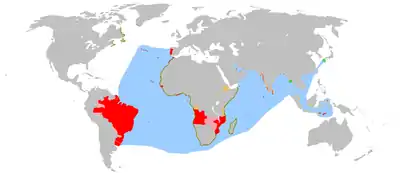Captaincies of Brazil
The Captaincies of Brazil (Portuguese: Capitanias do Brasil) were captaincies of the Portuguese Empire,[Note 1] administrative divisions and hereditary fiefs of Portugal in the colony of Terra de Santa Cruz,[Note 2] later called Brazil, on the Atlantic coast of northeastern South America. Each was granted to a single donee, a Portuguese nobleman who was given the title captain General. Except for two, Pernambuco and São Vicente (later called São Paulo), they were administrative and economic failures. They were effectively subsumed by the Governorates General and the States of Brazil and Maranhão starting in 1549, and the last of the privately granted captaincies reverted to the Crown in 1754. Their final boundaries in the latter half of the eighteenth century became the basis for the provinces of Brazil.[1][2][3][4]
Captaincies of Brazil Capitanias do Brasil | |||||||
|---|---|---|---|---|---|---|---|
| 1534–1549 | |||||||
.svg.png.webp) | |||||||
| Status | Colonies of the Portuguese Empire | ||||||
| Capital | Various capitals | ||||||
| Common languages | Portuguese | ||||||
| Religion | Roman Catholicism | ||||||
| Government | Monarchy | ||||||
| Monarch | |||||||
• 1534–1549 | John III | ||||||
| History | |||||||
• Established | 1534 | ||||||
• Disestablished | 1549 | ||||||
| Currency | Portuguese Real | ||||||
| ISO 3166 code | BR | ||||||
| |||||||
Establishment as colonies



Part of a series on the |
|---|
| History of Brazil |
 |
|
|
Following the successful expedition of Martim Afonso de Sousa in 1530, in order to exploit the trade in brazilwood discovered on the Atlantic coast, as well as explore rumors of vast riches in silver and gold in the interior, the Portuguese Crown determined to establish permanent colonies in their claim on the new continent. The Portuguese realized that they had no human or financial resources to invest in a large and distant colony, and decided to enlist private entrepreneurs, called donatários. Each would become owner and administrator of a capitania or captaincy, a land grant. This system had previously been successful in settling of the Portuguese colonies in Africa.
The captaincies were drawn as stripes parallel to the equator, commencing at the Atlantic coast and terminating in the west at the Tordesillas Line (where Spanish territory began). They were established by King John III of Portugal in 1534. Within a system of royal patronage and nepotism, five of the captaincies were given to two cousins of finance minister António de Ataíde: Martim Afonso de Sousa and his brother Pero Lopes. An additional captaincy was issued to Pero de Gois, captain of Afonso's 1530 expedition. The remaining captaincies were granted to a trusted mixture of military men (more precisely called conquistadores) and court bureaucrats.
Each captaincy was to be of fifty leagues "height" (measured north-south), but in practice, boundaries were marked by pairs of rivers, a plethora of which emptied into the Atlantic Ocean on the northeastern coast of the continent. So actual heights varied, as shown in the map at right. Initially fifteen, they were granted to twelve donees. They were the following (north to south):
| Captaincy | Donatário |
|---|---|
| Captaincy of Maranhão (1st section) | Fernão Aires and João de Barros |
| Captaincy of Maranhão (2nd section) | Fernando Álvares de Andrade |
| Captaincy of Ceará | António Cardoso de Barros |
| Captaincy of Rio Grande | João de Barros / Aires da Cunha |
| Captaincy of Itamaracá | Pero Lopes de Sousa |
| Captaincy of Pernambuco | Duarte Coelho Pereira |
| Captaincy of Bahia (Baía de Todos os Santos) | Francisco Pereira Coutinho |
| Captaincy of Ilhéus | Jorge de Figueiredo Correia |
| Captaincy of Porto Seguro | Pero Campos de Tourinho |
| Captaincy of Espírito Santo | Vasco Fernandes Coutinho |
| Captaincy of São Tomé | Pero de Góis da Silveira |
| Captaincy of São Vicente – 1st section (from Parati to Cabo Frio) | Martim Afonso de Sousa |
| Captaincy of Santo Amaro (from Bertioga to Parati) | Pero Lopes de Sousa |
| Captaincy of São Vicente – 2nd section (from Cananéia to Bertioga) | Martim Afonso de Sousa |
| Captaincy of Santana (from Cananéia to Laguna) | Pero Lopes de Sousa |
All but four captaincies failed, due to inadequate resources of the donees and lack of support from the Crown. Four donees failed to take possession of their lands, and four more quickly succumbed to Indians. Only four captaincies survived past 1549: São Vicente, Pernambuco, Ilhéus and Porto Seguro.[6]
Subsumption by Governorates
In 1549, in order to solve the governance problem of his South American colonies, King John III of Portugal established the Governorate General of Brazil. The governorate united the fifteen colonies into a single colony, but each captaincy would continue to exist as a privately owned provincial administrative unit of the governorate. In 1572, the Governorate was split into two separate Governorates: the Governorate General of Bahia in the north, which included Bahia (and Ilhéus, which was merged with Bahia) and captaincies to the north, and the Governorate General of Rio de Janeiro in the South, which included all the captaincies south of Bahia/Ilhéus. Thereafter, the Governorates split and merged, shuffling captaincies among them.
Crown captaincies and provinces
Beginning as early as 1548 when the captaincy of Baía de Todos os Santos (Bahia)[Note 3] reverted to the Crown due to death of its donee, the captains donatory failed financially and faded from the picture one by one. Their powers then reverted to the Crown, and the donatary captaincies became Crown Captaincies with royal officials in place of the former grantees.
The history of the captaincies is one of constant subordination, annexation and division. New donatary captaincies were carved out of territories which were too vast and difficult to administer directly and small captaincies, nominally in private hands but often abandoned by their donataries, were annexed by larger or more successful Crown captaincies. At least fifteen donatary captaincies were granted through the middle of the 18th century, carved out of royal captaincies. New royal captaincies were also carved out of existing ones.
During the Philippine Dynasty, some of the captaincies attained the status of provinces with royal governors (i.e. "states"), and Portuguese Brazil thereafter was a mixture of donatary captaincies, royal captaincies and states.
List of post-1549 captaincies

Some complications result from captaincies being merged and recreated with the same name, but representing altered regions. At least a few of the later captaincies were islands or capes of negligible size. Dates are of independent captaincies; in some cases, new captaincies were created as administrative divisions or subcaptaincies of existing ones before becoming fully independent (i.e. Para was established as early as 1616 as a north and westward annex of Maranhão).
- Fernando de Noronha (not occupied or abandoned) 1504-1737
- Itaparica and Itamarandiba (islands), 1556, split from Bahia
- Rio de Janeiro, 1563, renamed first (northern) section of São Vicente + Paraiba do Sul(?)
- Paraguaçu, 1566, carved from Bahia
- Paraíba, 1580, created from part of Rio Grande, enlarged by acquisition of most of Itamaracá, 1585
- Rio Grande de Norte, 1597, merger of northern portion of Rio Grande, Ceara and Maranhão
- Cabo Frio, 1615, promontory in Rio de Janeiro
- Pará, ~1616 as division of Maranhão from newly incorporated territory west of the Tordesillas Line; independent in 1652
- Itapecuru (renamed Icatu after 1691), 1621
- Caeté (originally Captaincy of Vera Cruz de Gurupi), 1622, merged into Maranhão 1654
- Itanheim, 1624
- Paranaguá, 1624
- Paraíba do Sul (originally São Tomé), 1629
- Gurupa, 1633
- Santa Cruz de Cametá, within Grão-Para on the lower Amazon, 1633 (see Cametá)
- Rio São Francisco, ~1634
- Cabo Norte, 1637, from newly incorporated territory; merged into Maranhão 1654
- Vigia, 1652
- Ilha Grande (island of Marajo), 1665, merged into Maranhão
- Xingu, 1685, within Maranhão
- Ararobá, 1690, within Pernambuco
- São Paulo and Minas de Ouro, 1709, renamed from São Vicente
- Minas Gerais, 1720, split from São Paulo and Minas de Ouro
- São Paulo, 1720, remaining after Minas Gerais split
- Mearim, 1723, within Maranhão
- Cuma, 1727, sub-captaincy split from Maranhão;
- Santa Catarina, 1739, split from São Paulo
- Goiaz, 1748, split from São Paulo
- Mato Grosso, 1748, split from São Paulo
- São José de Rio Negro (most of Amazonia region), 1755, split from Pará
- Grão-Pará, 1755, renamed portion of Pará after Rio Negro split
- Piauí, 1759, split from Maranhão
- Espírito Santo, 1799, independent from Bahia
- Rio Grande do Sul, 1760, newly incorporated territory of Rio Grande de São Pedro
- Ceará, 1799, split from Pernambuco
- Rio Grande do Norte, 1808, split from Pernambuco
- Alagoas, 1817, split from Pernambuco
- Colônia de Caiena e Guiana, 1809, annexation of French Guiana
- Sergipe, 1820, split from Bahia
Pernambuco and São Vicente
The Captaincy of Pernambuco thrived due to sugarcane plantations. The Captaincy of São Vicente, called São Paulo after the city of São Paulo became its capital in 1681, obtained success through the exploration of the hinterland known as bandeiras. In 1621, these became the basis for the southeastern State of Brazil.
Provinces of Brazil
In 1815, the State of Brazil was elevated to a kingdom and all existing provinces and Crown captaincies became provinces of the United Kingdom of Portugal, Brazil and the Algarves.
Legacy of the Captaincies
Thirteen modern states have names of their predecessor captaincies, and several cities. The captaincies immortalized a set of Tupi-guarani place names, chiefly those of rivers and mountains.
In echoes of the feudal system of landed noblemen, the huge fazendas of the 18th and 19th centuries were allocated from the land holdings of the captaincies.
Brazil today still lives with the legacy of a plantation culture that consumed four million African slaves and left land ownership hideously askew. An elite 1.7 percent of the landowners continue to own nearly half the arable land; the top 10 percent of the nation earns half the income.
See also
Notes
- in Portuguese, Capitanias Hereditárias, from capitão, in English captain
- Land of the Holy Cross
- Bay of All Saints
References
- "donatario (Portuguese history)". britannica. Retrieved 31 January 2014.
- "Discovery and Colonization (1500 – 1808)". soulbrasileiro.com. Retrieved 31 January 2014.
- "International Workshop on Ultracold Rydberg Physics". Retrieved 31 January 2014.
- "American Colonies - Brazil". historyfiles.co.uk. Archived from the original on 26 January 2011. Retrieved 31 January 2014.
- Cintra, J. P. (2013). "Reconstruindo o mapa das capitanias hereditárias". Anais do Museu Paulista: História e Cultura Material. 21 (2): 11–45. doi:10.1590/S0101-47142013000200002.
- Delpar, H.(2000) A Reference Guide to Latin American History p.92. M E Sharpe Inc. ISBN 978-1563247446
